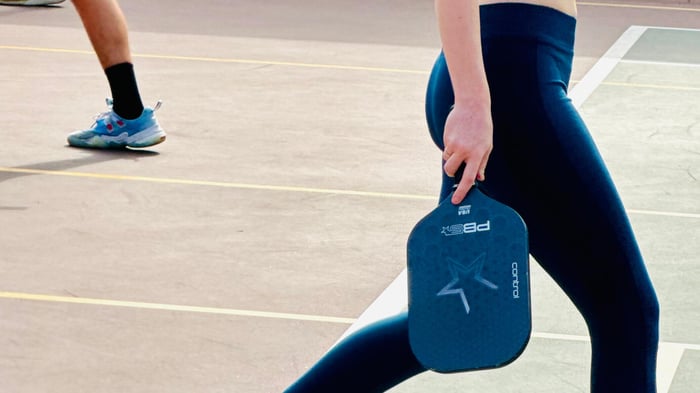Key takeaways:
Anticipation skills give players a major advantage when they can read subtle body cues and paddle positions before their opponent commits to a shot.
Training with purpose-built drills helps build the reaction speed and court awareness needed to turn fast-paced rallies into opportunities for control.
When you pair strong anticipation with intentional strategy, such as tracking opponent tendencies and placing shots with purpose, it enhances your play by helping you respond smarter, not just faster.
Anticipation is the secret weapon behind every clutch play in pickleball. It's what turns a close rally into a game-winning shot and separates quick reflexes from real control. When players can predict what's coming before it happens, they set the pace and dominate the court. This skill isn't just about fast feet. It's about mental sharpness and game IQ.
Competitive players rely on more than quick reflexes. Staying sharp on the court takes strategy, awareness, and gear that allows for free movement and focus. That's why many trust PB5star for high-performance apparel designed for the demands of the game. With the right mindset and tools, players can read shot patterns, track paddle angles, and anticipate movements to shift from defense to offense. Experience and smart practice turn good instincts into game-changing decisions.
The role of anticipation in improving your pickleball game
Once players master the basics of positioning and reaction, anticipation becomes the next game-changer. It bridges the gap between reacting to a shot and owning the point.
Consider those moments when everything flows. Being in place before the ball crosses the net isn't luck. It's built from focused practice and sharp court awareness. Many players develop this by blending drills with real game experience, gradually building the instincts that drive high-level play.
Recognizing patterns and responding with confidence can shift the game's rhythm. Reacting to last-minute scrambles with controlled, well-placed shots gives players the opportunity to reclaim the point and shift the match's energy.
Once you’ve learned how to anticipate the ball, the next step is learning to anticipate the player. That means tuning into subtle cues and body language that reveal exactly what your opponent plans to do next.
How to read your opponent and anticipate their next move
Think of reading your opponent like having a sneak peek at their next move. It all starts with the small details, such as paddle angle, body position, and footwork, which often reveal what shot is coming before the paddle even swings. Here are some anticipation skills to outsmart your opponent:
If the paddle is tilted downward, expect a drop shot. An open paddle face? That usually signals a soft dink or a high lob.
Body language speaks volumes:
Fast, aggressive steps toward the kitchen line suggest an attacking play.
Hesitant or shuffling movement points to a defensive mindset.
Advanced shots like the "Bert" are rarely spontaneous. They follow patterns in movement and paddle prep. Spotting these tells early gives you time to respond. Learn more about the Bert shot using our guide.
Under pressure, most players revert to habits. If you notice them favoring a particular shot, counter it with a varied tempo or an unexpected lob.
And don't keep those insights to yourself. Share what you see with your partner so you can both play smarter and stay in sync on the court.
Exercises to enhance reflexes and anticipation
To make anticipation second nature, players need focused, high-intensity drills that simulate real court scenarios. It's not just about reacting. It's about reacting with control, confidence, and speed. The drills below are designed to refine reflexes while building muscle memory that translates directly to game performance.
Quick catch challenge
This simple drill builds explosive reactions and improves your hand-eye coordination, two skills that are essential when you're at the net or reacting to fast serves. It's a great starting point for players who want to sharpen their instincts without needing a full court.
Partner drops a ball from shoulder height
Catch before the second bounce
Start near the net and increase the distance to raise the difficulty
Zone defense drill
Zone-based movement is a key skill in pickleball, especially when it comes to defending unpredictable shots and covering angles quickly. This drill sharpens your ability to make fast, decisive moves under pressure and reinforces the habit of staying alert and mobile. Responding to hand signals and shifting across different zones mimics the directional chaos of real match play, helping you refine lateral movement and boost your on-court awareness.
Use hand signals to identify court zones
React quickly and move with control
Alternate roles to keep both players sharp
Shot recognition practice
Sharpening your ability to anticipate shots starts with observation. By studying an opponent's body language and paddle position, you can often identify what's coming before the ball leaves their paddle.
Stand at the baseline
Observe paddle angle and footwork
Call out the expected shot before contact
Progressive volley series
This series is all about building timing and responsiveness through rhythm. Starting slow and gradually increasing pace helps you dial into your partner's cues, reinforcing anticipation as conditions change. It's an excellent bridge between controlled practice and live play.
Start with slow volleys at the kitchen line
Increase speed gradually
Focus on paddle cues and opponent positioning
Rapid response drill
Reflex training doesn't have to be complicated to be effective. This high-intensity exercise challenges your ability to stay sharp under pressure while reinforcing the importance of staying light on your feet. By moving between shots with speed and precision, you're training your body and mind to respond under pressure, just like in a real match.
Partner feeds balls quickly to different zones
Emphasize footwork, accuracy, and mental focus
Simulates fast match play
With those core drills in place, it's time to connect anticipation to a broader match strategy. This means making smarter decisions based not only on where the ball is going but also on your opponent’s tendencies and your ability to control momentum.
Developing strategic thinking to outsmart opponents
Top athletes don't wait for the rally to start making decisions. To truly outsmart opponents, players need to combine their instincts with thoughtful tactics. They begin analyzing the game from the warm-up, identifying patterns and preferences before the first serve is even hit. This approach lets them predict and adapt rather than simply respond.
Watch warm-up patterns
When under pressure, many players instinctively rely on their go-to shots, those they've practiced the most or feel most confident executing. Recognizing these tendencies early can give you the upper hand, allowing you to anticipate and counter effectively during high-stress points.
Focus on footwork
Quick, controlled footwork is a foundation of smart play. Being balanced and agile allows players to respond faster and position themselves for stronger returns. PB5 Court2 shoes are built for this kind of responsiveness, helping athletes stay light on their feet and confident in every lateral move.
Change pace frequently
Varying the tempo of your shots keeps your opponent guessing and disrupts their rhythm. Blend fast-paced drives that apply pressure with soft dinks that require finesse. This contrast forces them to constantly adjust, opening the door for unforced errors or exploitable gaps in positioning.
Be patient at the kitchen
At the kitchen line, patience is a powerful weapon. Rather than forcing a risky shot, learn to wait for your opponent to make the first mistake, like drifting out of position or exposing their backhand. Timing is everything in this zone, and controlling it gives you the edge.
Spot weaknesses
Every player has a weak spot, whether it's handling high lobs, backhand returns, or off-balance plays. Pay attention to these vulnerabilities early in the match. Once identified, adjust your shot placement to challenge those areas consistently. This not only increases your chance of winning points but also keeps your opponent uncomfortable and reactive.
Frequently asked questions about anticipation skills
No matter your experience level, understanding how to sharpen anticipation can unlock smarter, more confident play. After understanding how strategy elevates your game, it’s natural to want answers to some of the most pressing on-court challenges. Here’s what players like you often want to know:
What's a simple way to begin reading opponents better?
If you're new to reading opponents, start with the basics: paddle position and stance. These visual cues give you the first clues about shot intent. To build this skill intentionally, try this anticipation drill guide from PB5star. It breaks down step-by-step how to spot tells before contact.
How can you improve your reaction time for better anticipation?
Rather than just relying on instinct, focus on quick decision-making. Reaction drills like the zone defense or rapid ball feed build split-second recognition skills. These can turn reactions into proactive play.
Does gear really affect anticipation, or is it just comfort?
Gear won't make decisions for you, but it clears distractions. Lightweight court shoes and flexible apparel help you stay fully mobile and mentally dialed in. PB5star's performance gear is made with pickleball-specific movement in mind, giving you the confidence to stay focused.
How can you work on anticipation when you're not playing?
Table tennis, video analysis, and hand-eye drills can all reinforce quick reads and pattern recognition. Off-court strategy sessions, like reviewing matches with a coach or partner, help build the mental library needed to anticipate more effectively in-game.
How can experienced players keep improving their anticipation?
At a higher level, refining anticipation comes down to fine-tuning awareness and staying mentally agile. Advanced players should focus on reading subtle cues that indicate an opponent's intentions. Slight grip changes or shifts in body weight often reveal whether a drive, lob, or dink is coming, and recognizing just one of these can offer a decisive edge during fast-paced exchanges.
Take your pickleball game further with PB5star
Great anticipation makes every move on the court feel sharp and intentional. It helps players stay in control from the first serve to the final point, ensuring every move contributes to a smarter, more strategic game. The real value lies in what anticipation unlocks: smarter plays, better positioning, and stronger decision-making under pressure.
Working on your anticipation doesn’t just sharpen your skills. It changes how you think and compete on the court. Ready to push your game further? Check out PB5star for gear that supports players who play smart, move fast, and always stay one step ahead.







